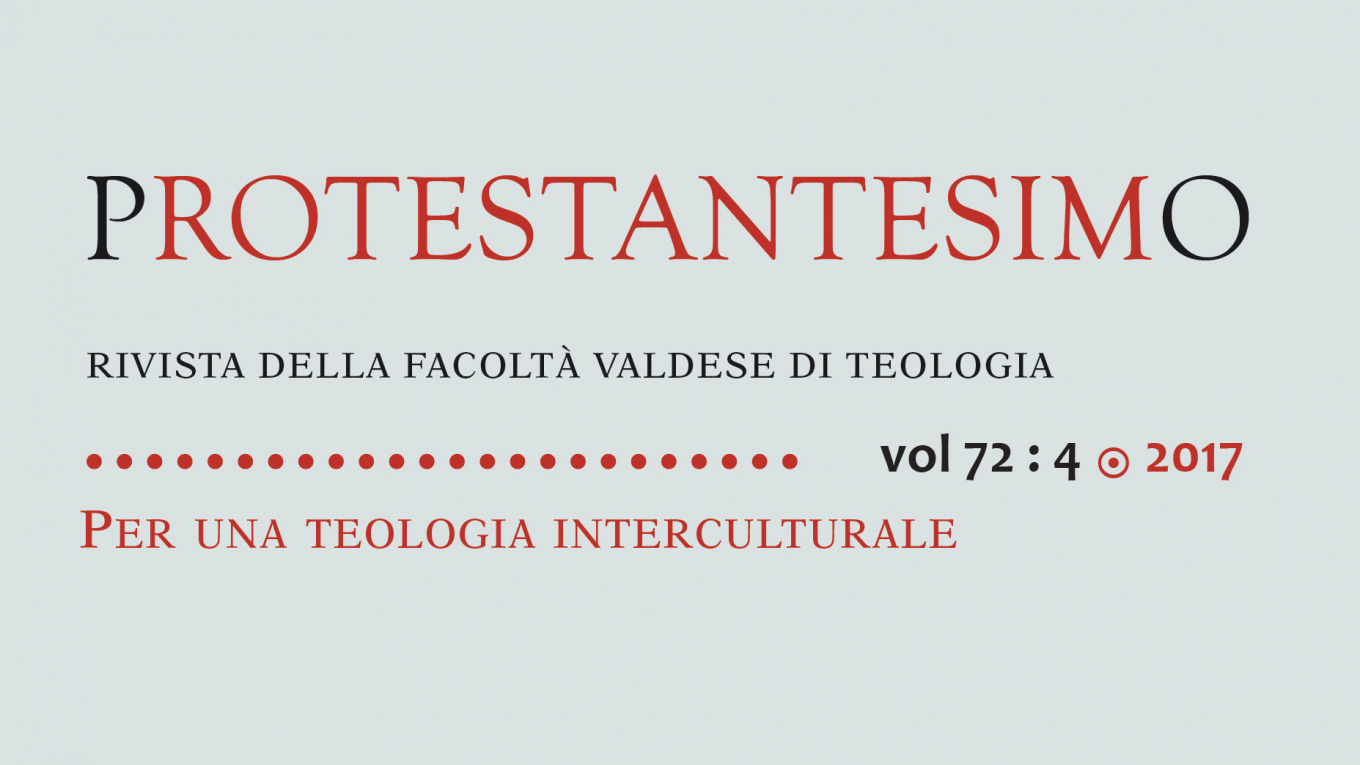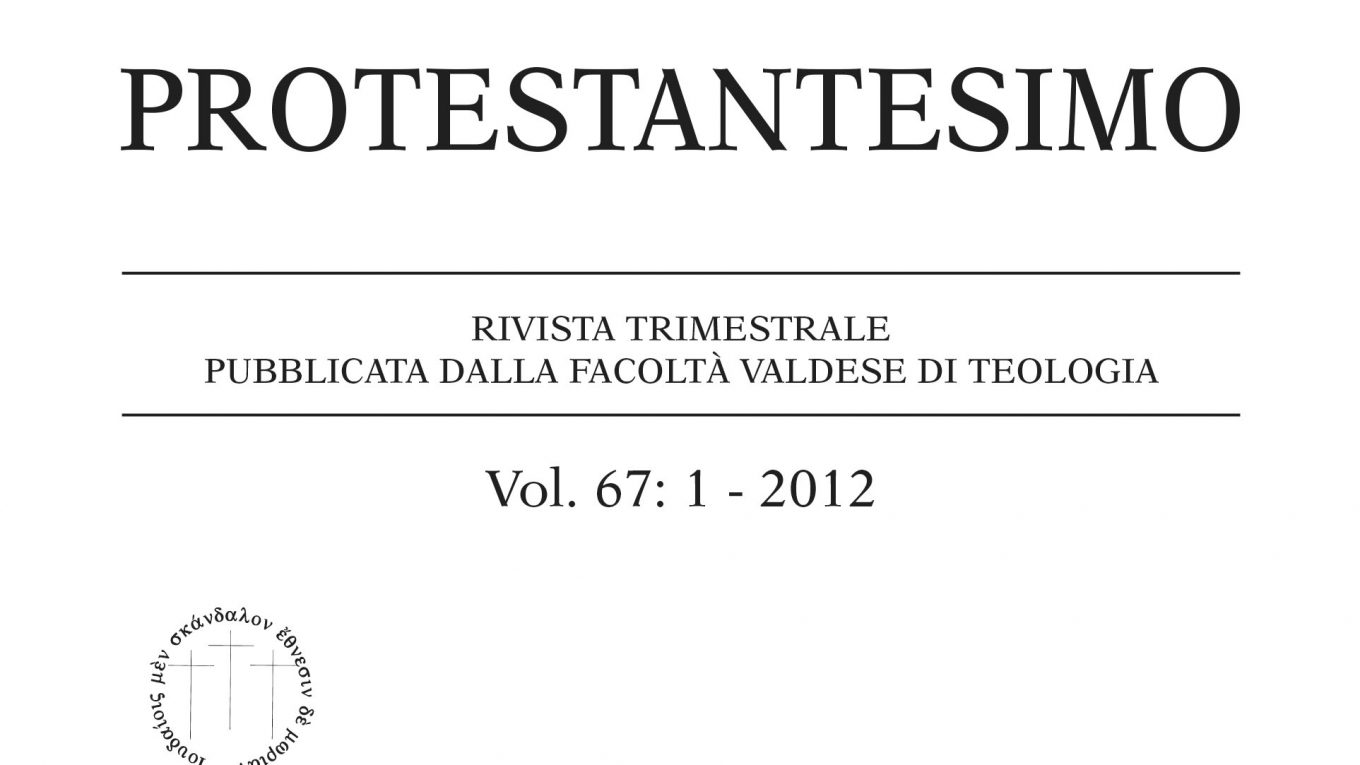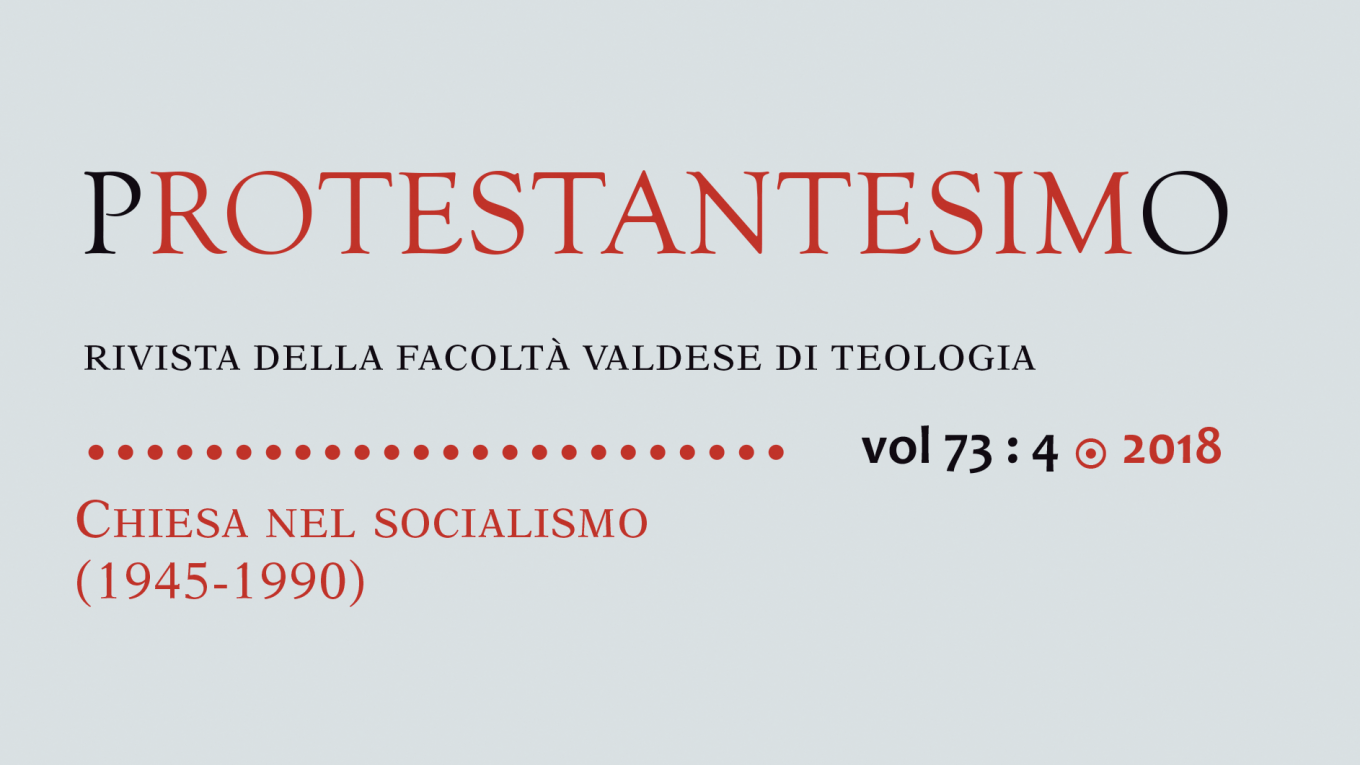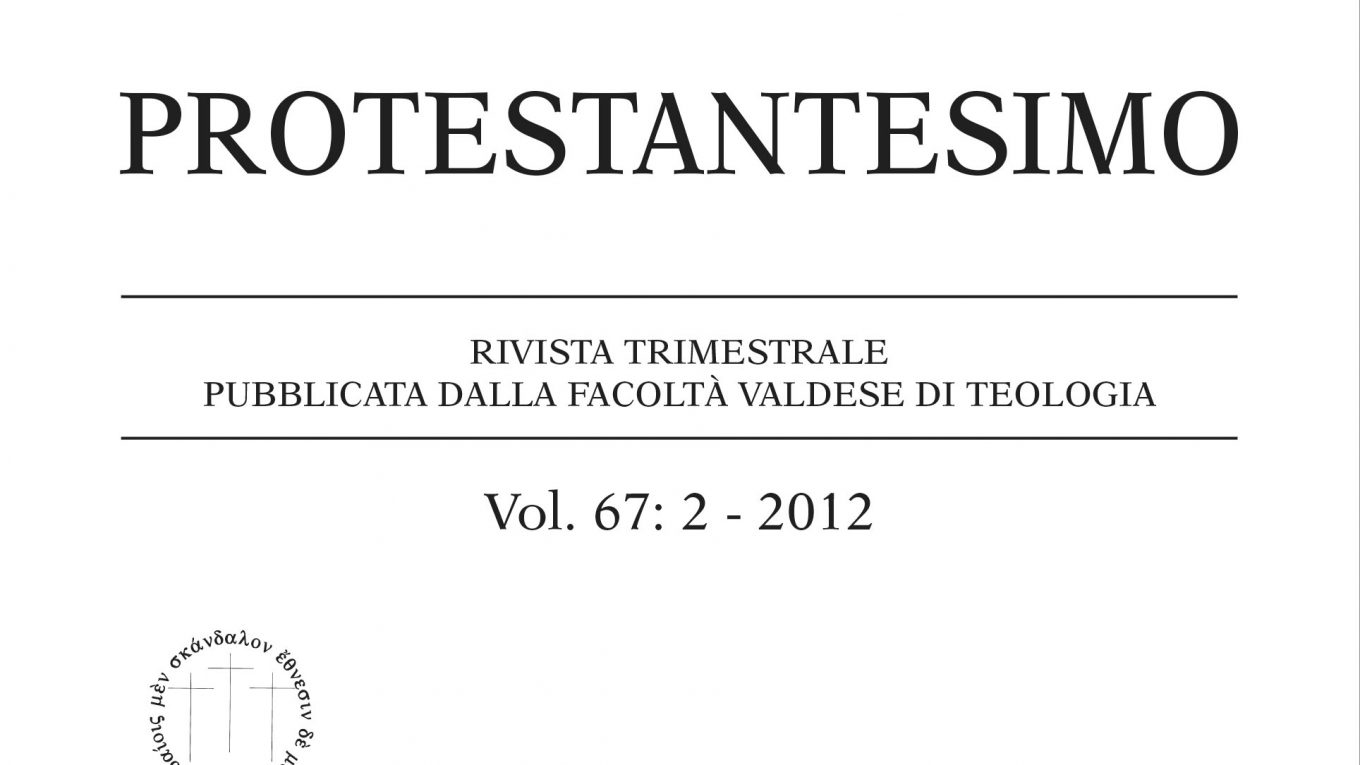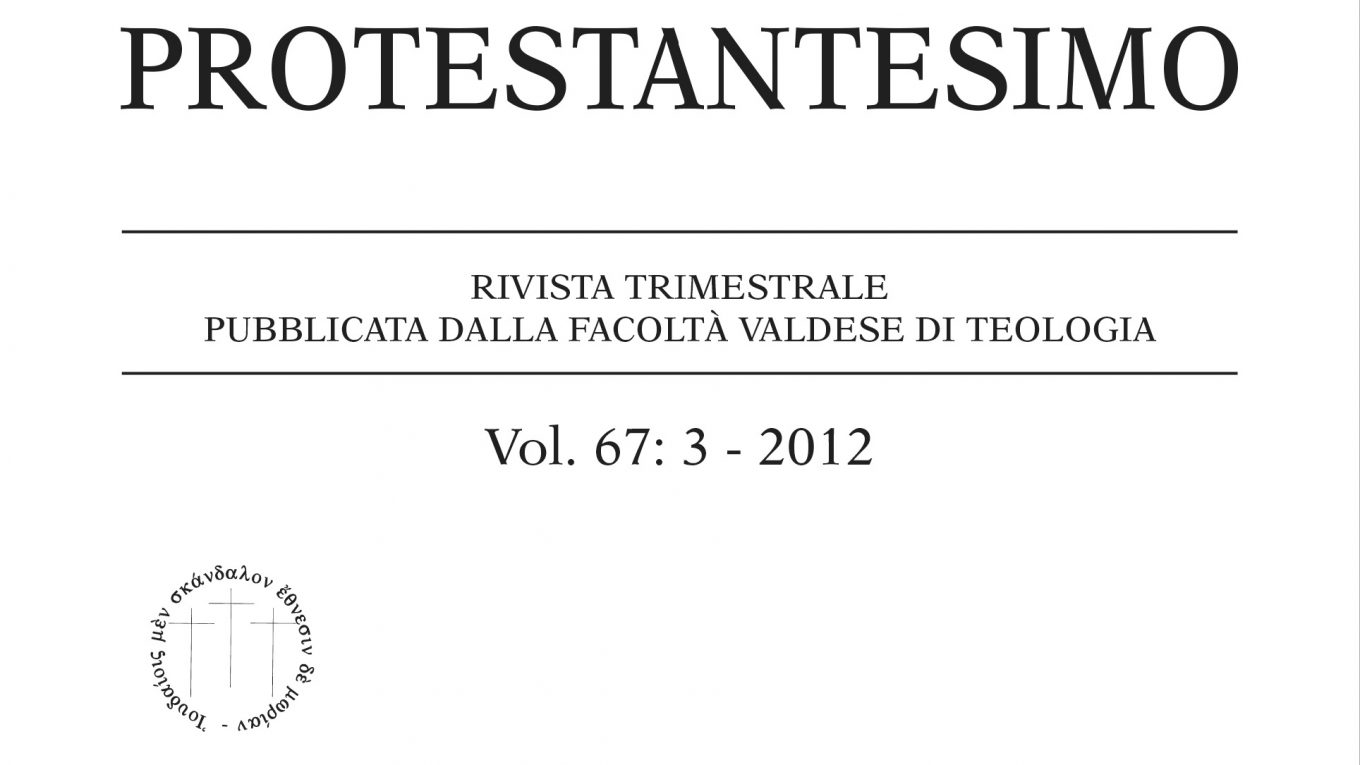Autore: wp_5978506
abstract vol 64 : 1
L. Vogel, «Per tutti i giorni della vita». Il concetto di penitenza nei testi dei barba valdesi tardo medievali
L’esigenza di una prassi continua della penitenza si manifesta sia nei mano- scritti dei barba, sia nelle 95 tesi di Martin Lutero. Un confronto più attento tra le comprensioni di questo topos nelle due fonti menzionate rivela, però, differenze importanti. Al di là del consenso nel rifiuto di un’ecclesiologia che vedeva la chiesa gerarchica come amministratrice della salvezza, la dottrina penitenzia- ria dei manoscritti dimostra riserve verso ogni tipo di funzione vicaria, mentre in Lutero la croce di Gesù stabilisce il basilare extra nos della salvezza.
L. Vogel, «For all the days of our life». The idea of penitence in the writings of Waldensian barba in the late Middle Ages
Continuous penitence is seen as necessary both in the documents of Walden- sian barba and in Luther’s 95 Theses. However, if we look closely at these two sources, we will notice some important differences. Both Luther and the Waldensians refused the idea that a hierarchical church could determine salvation. Indeed the Waldensian documents express a doubt that there could be any institutional go-between for God, while for Luther the Cross represents the cru- cial extra nos of our salvation.
S. Noceti, Dietro, sopra, davanti, sotto gli altari. Donne pastore e trasformazioni del piano simbolico e relazionale
L’articolo, che sviluppa una relazione tenuta dall’A. in occasione della «Giornata Miegge» 2007, prende in esame i cambiamenti avvenuti nella chiesa valdese dopo la consacrazione di donne pastore nel 1967. Nella prospettiva aperta da gender studies, avvalendosi di apporti di sociologia delle istituzioni e di «teoria della performance», l’A., teologa cattolica-romana, individua e interpreta le trasformazioni avvenute a livello di autocoscienza dei soggetti coinvolti (uomini e donne), sul piano della forma e della prassi ecclesiale (nei ruoli, nelle relazioni strutturate, nell’esercizio del potere), nella reinterpretazione dello stesso ministero pastorale. Vengono infine segnalate le implicazioni per il contesto sociale e per il dialogo ecumenico in Italia.
S. Noceti, Behind, above, in front of, under the altars. Women pastors and transformations at symbolic and relational level
This article is a re-working of a conference Noceti gave for «Giornata Miegge» 2007. She looks at changes in the Waldensian Church after women began to be ordained pastors in 1967. This article is a contribution to gender studies and makes use of the sociology of institutions and of performance theory. Noceti is a Roman Catholic and here she identifies and interprets the transformations which occurred in the way people saw themselves, both men and women. She also considers formal and practical changes in roles, structural relationships, and the exercise of power. She shows how pastoral ministry was reinterpreted. Finally she discusses the implications of these changes for the social context and for ecumenical relations in Italy.
S. Ronchi, O l’onore di Dio od «ossa più pregevoli delle pietre preziose». Giovanni Calvino e il culto delle reliquie
Il culto delle reliquie trova nella Riforma una netta opposizione sulla base del divieto di farsi immagini di Dio (Es. 20,4-6). Calvino, in particolare, dedica a tale grave deformazione della fede cristiana il Trattato sulle reliquie (1543), in cui affronta la questione delle false reliquie e ribadisce la centralità dell’onore di Dio, concetto teologico centrale nel suo pensiero.
S. Ronchi, Either the honour of God or «bones more precious than precious stones». John Calvin and the cult of relics
The opposition of the Reformation to the cult of relics was based on the Commandment against making images of God (Exodus 20. 4-6). Calvin focuses on this serious deformation of Christian religion in his A Treatise on Relics (1543) where he discusses the question of false relics and reaffirms the concept of honouring God which is at the heart of his theology.
E. Bein Ricco, La democrazia e la sfida del multiculturalismo
Le democrazie del nostro tempo, destinate a diventare sempre più multi- culturali, multietniche e multireligiose, si trovano a dover affrontare un interrogativo stringente: come si organizza una società complessa in cui coesistono gruppi identitari caratterizzati da visioni culturali e religiose spesso in contra- sto tra loro? L’A. mette a confronto alcune tra le più significative risposte che oggi vengono date all’ardua sfida del multiculturalismo e della convivenza non facile tra diversi.
E. Bein Ricco, Democracy and the challenge of multicultural society
The democracies of our time are destined to become more and more multi- cultural, multiethnic, and multi-religious. They therefore need to face a difficult question: how can we organise a complex society in which different groups are characterised by cultural and religious visions which often conflict? Bein Ricco compares some of today’s most important answers to the challenge of a multicultural society where different people live together, often with some difficulty.
S. Nitti, Gli scritti riformatori del 1520
Il contributo presenta la nuova edizione italiana, con testo originale a fronte, degli scritti riformatori di Lutero del 1520. L’autrice sottolinea il significato culturale dell’operazione, ma anche il fatto che la riflessione luterana assume, nel dibattito culturale ed ecumenico dell’Italia odierna, una rinnovata attualità.
S. Nitti, Luther’s Reformation Writings, 1520
Nitti presents the new Italian edition of Luther’s Reformation writings of 1520. The original text is printed on facing pages. She emphasises the cultural contribution of this edition, but also adds that Lutheran thought can make a contemporary comment on the cultural and ecumenical discussion going on in Italy today.
L. Vogel, Johann Gerhard. Edizione critica delle opere
L’articolo discute due volumi della recente edizione critica (testo originale e tedesco del xvii secolo) delle opere del teologo luterano Johann Gerhard presentando al tempo stesso il profilo di questo protagonista dell’ortodossia luterana. L’A. sottolinea gli elementi di continuità di Gerhard rispetto a Lutero, ma anche la forte originalità teologica e spirituale dell’A.
L. Vogel, Johann Gerhard. A critical edition of his work
This article looks at two volumes of the recent critical edition of the works of the Lutheran theologian Johann Gerhard. They include the original text and a 17th century German translation. The article also offers informations about Gerhard, a major thinker of the Orthodox Lutheranism. Vogel notes the elements of continuity between Gerhard and Luther, but he also emphasises Gerhard’s theological and spiritual originality.
J. Lauster, A proposito di un’opera italiana recente
L’A., professore di dogmatica a Marburgo, presenta criticamente il volume di F. Ferrario, Dio nella Parola. La prospettiva teologica generale che sostiene il libro non è condivisa dal recensore, il quale tuttavia ritiene che Dio nella paro- la possa offrire un apporto al dialogo tra prospettive teologiche che, fino a ora, si sono sostanzialmente contrapposte.
J. Lauster, On a recent italian book
The A. is professor of Dogmatic Theology at Marburg. In this article he discusses F. Ferrario’s book Dio nella Parola. Lauster disagrees with Ferrario’s general theological position. He stresses however that the book can contribute to the dialogue between different theological points of view, which heretofore have been essentially at odds.
abstract vol 61 : 1
Philip Gossett, I protestanti nell’opera lirica
Testo della prolusione del prof. Philip Gossett, in occasione dell’apertura del CLI Anno accademico della Facoltà valdese di Teologia. A lungo, nell’opera lirica, le differenze religiose non appaiono caratterizzate da musicalità diverse. Nel secondo quarto del XIX secolo si incomincia a introdurre un colore locale cercando di tradurre in musica differenze etniche. Ne Les Huguenots (1836) di Giacomo Meyerbeer (1791-1864) la musica riflette la drammatica contrapposizione tra ugonotti (che cantano anche Forte rocca) e i nobili cattolici. In Stiffelio di Giuseppe Verdi (1850), il protestantesimo è fondamentale; non solo tutti i personaggi sono protestanti, ma si affronta un problema spirituale: come può un pastore predicare la Parola di Dio mentre la sua vita è travagliata dalle esperienze e dai sentimenti che possono capitare a tutti, in questo caso quelli legati alla scoperta del tradimento della moglie? La censura austriaca occultò ogni ri- ferimento alla Bibbia e al protestantesimo, ma dalla ricostruzione del testo critico emerge con quale incisività Verdi seppe affrontare un tema interiore e spirituale, che corrispondeva al suo proposito di innovare l’opera lirica, alla sua tensione etica e forse anche rispondeva all’ostilità che egli avvertiva per la sua relazione con una donna sposata. Nell’Ottocento l’opera non ebbe successo, nessuno capì la tensione che la animava. Oggi che la possiamo rivedere nella for- ma che Verdi le volle dare, essa ci parla, e con grande intensità.
Philip Gossett, Protestants in Opera
This is the text of a Lecture by Prof Philip Gossett for the opening of the 151st academic year of the Waldensian Theological Seminary in Rome. Religious differences were not characterised by particular musical differences in opera for a long time. In the second quarter of the 19th century composers began to intro- duce local colour in an attempt translate ethnic differences into a musical idiom. In Giacomo Meyerbeer’s Les Huguenots (1836) the music reflects the dramatic opposition between the Huguenots (who even sing A mighty fortress) and the noble Catholics. In Giuseppe Verdi’s Stiffelio (1850), Protestantism is fundamental. All the characters are Protestant and in addition the opera poses a spiritual question: how can a pastor preach the word of God while his own life is in crisis due to experiences and feelings which might happen to anyone, in this case connected to his wife’s adultery? Austrian censorship removed all references to the Bible and to Protestantism, but a critical reconstruction of the text shows us just how incisively Verdi treats this inner, spiritual theme. Indeed it is a good example of the way in which Verdi wished to renew opera and illustrates his own inner tensions and perhaps also the hostility he experienced for his relationship with a married woman. The opera was not a success in the 19th century and no one really understood the tension that breathes through it. Now that we can see and listen it in Verdi’s original version, however, it speaks to us with great intensity.
Gianni Long, Giorgio Peyrot. Un profilo
L’Autore, professore di diritto parlamentare alla LUISS e attuale Presidente della Federazione delle Chiese Evangeliche in Italia, percorre sinteticamente (per l’approfondimento, si rinvia al contributo successivo) l’opera del giurista evangelico recentemente scomparso, dai dibattiti intorno all’Assemblea costituente fino a quelli relativi all’accettazione o meno dell’otto per mille da parte delle chiese valdesi e metodiste.
Gianni Long, Giorgio Peyrot. A Portrait
The Author – professor of Parliamentary Law at LUISS University and President of the Federation of Protestant Churches in Italy – gives a brief sum- mary of the work of this Protestant lawyer and legal expert who recently died. It covers the period from the Constitutional Assembly to the recent debates on whether the Waldensian and Methodist Churches should accept the eight per thousand from the state on tax returns.
Franco Giampiccoli, In memoria di Giorgio Peyrot
Nel trentennio in cui l’ordinamento valdese è stato profondamente rielaborato (1953-83), Giorgio Peyrot ha svolto un ruolo preminente in quattro ambiti. Ha impostato il lavoro del quindicennio che ha portato nel 1974 al varo della Disciplina generale, la cornice che racchiude l’unione delle chiese valdesi di qua e di là dell’Atlantico, centrata su un unico sinodo articolato in due sessioni. Ha condotto l’ultima fase delle trattative per l’integrazione tra valdesi e metodisti iniziate nel 1942 e concluse con i Patti di Integrazione del 1975-79. A par- tire dal 1948 ha propugnato l’utilizzo delle intese previste dall’art. 8 della Costituzione, in funzione di garanzia di libertà religiosa, fino alla trattativa effettiva, condotta con Giorgio Spini e Sergio Bianconi, tra il 1977 e il 1981. Nell’ambito della Commissione per le discipline, ha riordinato l’intera materia regolamentare in vista della pubblicazione della Raccolta delle Discipline vigenti nell’Ordinamento valdese (1983).
Franco Giampiccoli, In memory of Giorgio Peyrot
During the thirty years between 1953-1983 when the organisation of the Waldensian Church was profoundly transformed, Giorgio Peyrot played a key role in four different areas. He was responsible for the fifteen years of work which resulted in 1974 in the General Rules, the framework which unites Waldensians on both sides of the Atlantic in a single Synod with two sessions. He also led the final phase of the negotiations for the integration of the Waldensian and Methodist Churches, begun in 1942 and finally concluded in 1975-1979 with Integration Agreement. Then also, beginning in 1948 he was very much wanted to take ad- vantage of article 8 in the Constitution which offered churches the possibility of formal agreements with the Italian state. He saw this as a guarantee of religious freedom and participated in the negotiations led by Giorgio Spini e Sergio Bianconi between 1977 and 1981. Finally as a member of the Commission on Order he rearranged church rules for the publication of Collected Rules for the Ordering of the Waldensian Church (1983).
Yann Redalié, Il corpo e la prassi sportiva nella tradizione protestante
Lo sport moderno nasce nell’Inghilterra dell’Ottocento, risultato di una trasformazione educativa dei giochi popolari tradizionali e delle arti aristocratiche. In questa trasformazione, nella quale i movimenti, associazioni, scuole, collegi e università di tradizione protestante hanno avuto, in molti casi, un ruolo determinante, tutto accade come se i valori morali e educativi evidenziati nella gara sportiva, usata come metafora dalla filosofia del tempo di san Paolo e in parte rielaborata dall’apostolo, venissero reinvestiti direttamente nell’attività sportiva stessa. La gara non è più solo metafora, diventa diretta portatrice di va- lori morali. In questa valorizzazione dell’attività sportiva, un posto di rilievo vie- ne riconosciuto alle Young Men Christian Associations (YMCA), che con le palestre, le piscine, l’invenzione della pallacanestro e della pallavolo, hanno avuto un ruolo di primo piano nella creazione e nella diffusione internazionale di nuovi modelli sportivi e nella formazione universitaria relativa allo sport.
Yann Redalié, The body and the Protestant sports tradition
Modern sports began in England in the 19th century when folk games and aristocratic contests were transformed and incorporated into the educational scheme. Protestant movements, associations, schools, colleges and universities played a vital part in this transformation, which attributed the moral and formative values of competition to the particular sports themselves. The metaphor of the race had been used by philosophers for a long time, and indeed the Apostle Paul used it and in part developed it, but now the metaphor gives way to the idea of the race as a moral attribute. The Young Men’s Christian Association (YMCA) played a significant role in promoting sports. The ‘Y’ with its gyms, pools, with the invention of basket-ball and volley-ball was instrumental in crea- ting and popularising new models of sportsmanship round the world and sports as an integral part of university education.
Albert De Lange, Carlo Papini, Valdo di Lione e i «Poveri nello spirito»
Il contributo presenta l’importante monografia di C. Papini I Poveri nello spirito, dedicata al primo secolo di storia valdese, evidenziandone la portata inno- vativa nell’ambito della storiografia sul movimento valdese.
Albert De Lange, Carlo Papini, Valdo di Lione e i «Poveri nello spirito»
A discussion of Carlo Papini’s important book, I Poveri nello spirito, which examines the first century of Waldensian history. In particular, De Lange shows how Papini’s book is innovative in its treatment of the movement.
Paweł Gajewski, Introduzione e Documento di studio della Commissione sinodale ad referendum sull’ecclesiologia
Pubblichiamo il documento presentato al Sinodo 2005 delle chiese evangeliche valdesi e metodiste dalla Commissione nominata per approfondire alcuni aspetti dell’ecclesiologia protestante nell’attuale contesto. Il Testo è preceduto da una densa presentazione del coordinatore della commissione, past. dott. Paweł Gajewski.
Paweł Gajewski, Introduction and Study document from the Synodical Commission for a referendum on Ecclesiology
This is the document presented at the 2005 Synod of the Waldensian and Methodist Churches by the Commission named to explore certain aspects of Protestant ecclesiology in the present context. The text is preceded by a rich pre- sentation by the Convenor of the Commission, Revd Dr Paweł Gajewski.
abstract vol 61 : 2
E. Noffke, Il sacrificio e il Tempio nel mediogiudaismo: storia di un divorzio consensuale
Il mediogiudaismo segna il passaggio da una religione sacrificale a due nuove, interamente svincolate dal sacrificio (giudaismo rabbinico e cristianesimo): com’è possibile che questo sia avvenuto senza particolari traumi? In realtà, numerosi segnali indicano che altre pratiche stavano sostituendo il sacrificio. Nella diaspora ellenistica in particolare, l’attenzione si era spostata dalla vittima al- l’attitudine morale del sacrificante. In generale, si diffonde l’idea che il sacrificio volontario di una persona possa indurre Dio a intervenire in favore del popolo, fino a perdonare i suoi peccati. Alcuni gesti, come le abluzioni, stavano assumendo una proprietà purificatoria prima attribuita ai soli sacrifici (forse anche il battesimo di Giovanni), per non parlare delle forti critiche alla gestione del sacrificio a Gerusalemme e del crescente spazio occupato dalla preghiera e dalla lettura della Torah. La distruzione del Tempio nel 70 non ha fatto altro che accelerare un processo in atto da tempo.
Middle Judaism was characterized by the passage from a religion based on sacrifices to two new religions without sacrifices, namely Christianity and Rabbinic Judaism. The main signs of this passage are the following: the attention was shifting from the sacrifice itself to the attitude and moral character of the one sacrificing, especially in Hellenistic Judaism; the idea that a person’s voluntary sacrifice could induce God’s intervention in favour of the people, even to the forgiveness of sins. Some acts, ablutions for instance, were substituting sacrifices as purification rites, which were first attributed only to sacrifices. It is even possible that John’s baptism was intended for this purpose. There was also strong criticism on sacrificial rites practiced at the Temple in Jerusalem and a growing devotion to prayers and the reading of the Torah. The Temple’s destruction in 70 just accelerated an ongoing process.
R. Carbone, Temporalità, relazione e angustia nell’esperienza effettiva della vita: Heidegger a confronto con Paolo e Lutero
Negli anni 1920-1923 Heidegger si confronta con il cristianesimo delle origini, in particolare le lettere di Paolo e con le opere del giovane Lutero. Nelle Lezioni sulla Lettera ai Romani e nella Disputa di Heidelberg il filosofo tedesco scopre gli strumenti e le argomentazioni per mettere in discussione la filosofia e la teologia cristiane. L’articolo si propone di analizzare come Heidegger interpreti i testi del giovane Lutero in relazione al significato del cristianesimo delle origini.
During 1920–1923 Heidegger studied the earliest period of Christianity, especially Paul’s letters, and in the same period also looked at Luther’s early works. In Luther’s Commentary on Romans and his Disputation in Heidelberg, Heidegger discovered the tools and points of discussion which he would then apply to Christian philosophy and theology. This article shows how Heidegger’s interpretation of Luther’s early works is related to his understanding of primitive Christianity.
E. Cerasi, Verso una comunità confessante. Le tesi di Yoder su Barth
Il saggio espone le tesi di Yoder sulla teologia politica di Karl Barth, letta co- me crisi della sintesi costantiniana di chiesa e Stato. L’ecclesiologia, ma anche la dottrina della santificazione esposta in KD IV/2, nonché le posizioni pacifiste maturate dagli anni Cinquanta in poi avrebbero condotto Barth verso la tradizione della free church. Dopo aver esposto le obiezioni di Hunsinger alle tesi di Yoder, l’articolo discute in particolare il saggio di Barth Christengemeinde und Bürgergemeinde.
This article discusses Yoder’s theory about Karl Barth’s political theology. Yoder reads Barth’s work as a point of crisis in the synthesis between Church and State effected by Constantine. Yoder believes that Barth’s ecclesiology, his doctrine of sanctification as expressed in KD IV/2, and the the pacifist position he developed beginning in the ’50s urged Barth towards a free church tradition. The article goes on to look at Hunsinger’s objections to Yoder’s theory and then discusses Barth’s essay Christengemeinde und Bürgergemeinde.
S. Rostagno, Million Dollar Baby
Partendo dalla pellicola Million Dollar Baby si fa emergere il messaggio di speranza che il film trasmette. Il «milione di dollari» esprime il valore di ciascuno di noi, valore che non si può dosare o misurare, aumentare o abbassa- re, ma deve soltanto essere riconosciuto. Si esamina, infine, il problema del- l’eutanasia.
Rostagno discusses the message of hope which lies buried in the film ‘Million Dollar Baby’. ‘A Million Dollars’ stands for the value of every individual, a value which cannot be quantified, measured, increased or decreased, but is only to be recognised. The article goes on to look at the question of euthanasia.
F. Ferrario, L’ecumenismo secondo Walter Kasper
L’autore esamina due recenti raccolte di saggi del card. Kasper. Essi delineano un progetto ecumenico al quale, a parere del recensore, le chiese della Riforma non potrebbero aderire se non a prezzo della loro stessa ragion d’essere.
The author looks at two recent collections of essays by Cardinal Kasper. They outline an ecumenical programme to which the author believes it would be impossible for the Churches of the Reform to agree without compromising the very reason for their existence.
G. Genre, Un’assemblea consapevole
L’autore, rappresentante della chiesa valdese alla recente assemblea del Consiglio ecumenico, traccia un sintetico resoconto dei dibattiti, nel quadro dell’attuale situazione dell’ecumenismo e del Consiglio.
Gianni Genre represented the Waldensian Church at the recent meeting of the Ecumenical Council. Here he summarises the debates for us and situates them in present ecumenical situation and the Council as it now stands.

